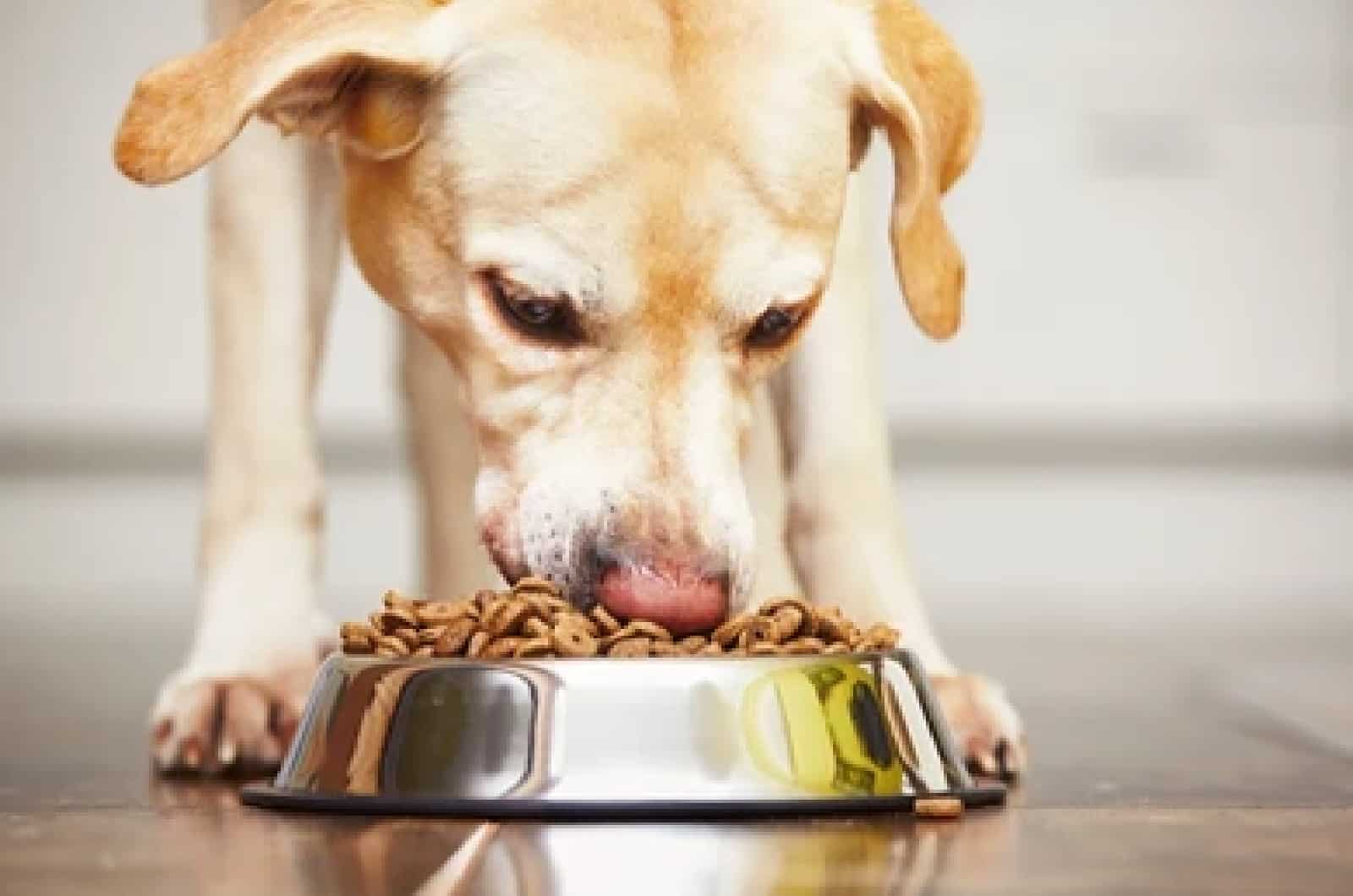Let’s start this Labrador feeding chart by saying that our lovely Labrador Retriever dogs are big dogs that love to eat! Everyone that has ever owned or known a Labrador Retriever puppy knows how much these pooches love their food!
Okay, now that we have made that clear, it’s time to talk seriously about feeding a Labrador Retriever.
Feeding a Labrador Retriever is quite easy, but every Lab dog owner should know that these dogs require a versatile healthy diet, not just plain and dry dog food.
This Labrador feeding chart serves as a Labrador feeding guide for all current and aspiring owners who want to know more about nutritional needs of their dog. Plus, it is not only about the nutritional needs of a Labrador Retriever.
We are going into detail about the most important ingredients that dog food for Labradors should consist of, as well as a regular feeding schedule each Labrador puppy must have for healthy development.
Without wasting any more time, let’s get straight into the Labrador feeding chart!
Labrador Feeding Chart Review
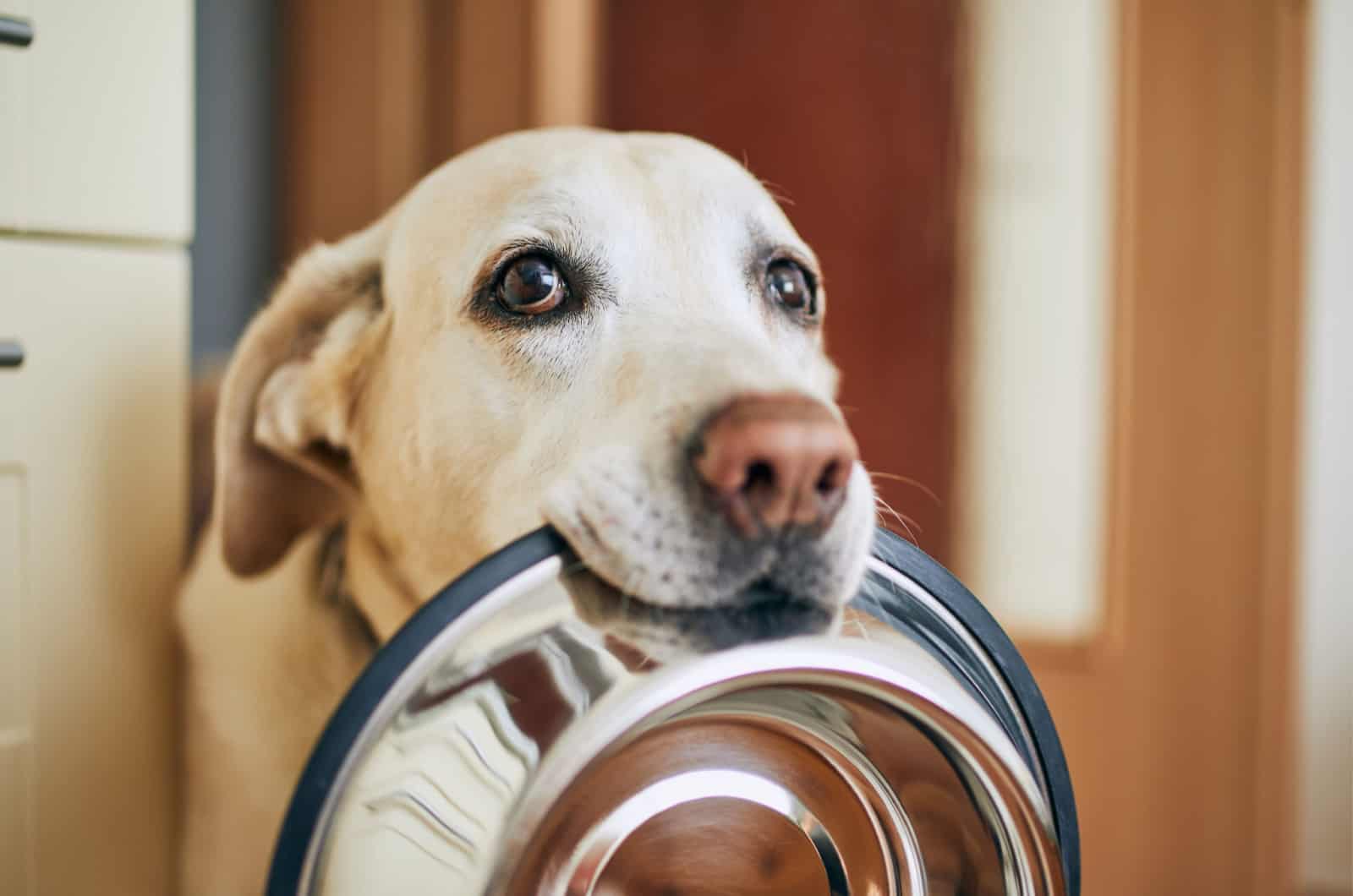
How Many Times A Day Should I Feed My Labrador?
If you are wondering how many times per day you should feed a Labrador puppy, here is a quick feeding chart that approximately explains your pup’s daily needs.
[table id=509 /]
You see, Labrador puppies require frequent meals that are rich in nutrients. That doesn’t mean that adult dogs require any less of a nutritional diet.
Adult Labradors should be fed two times per day — breakfast and dinner, with yummy treats in between.
How Much Food Should I Feed My Labrador?
This is a frequently asked question that most Labrador owners ask when they bring in their Lab puppy in development. Even those who own adult Labradors are unsure how much food they should give them.
Well, the previous feeding chart shows how many times you should feed your Labrador Retriever throughout its lifespan, but now we should mention how much food a Labrador Retriever needs.
The amount of food a Labrador Retriever dog needs depends on its weight. Labs are large dogs which means that they will need quite the food intake. But still not as much as the Cane Corso.
[table id=510 /]
When it comes to adult Labrador Retriever dogs, veterinarians recommend feeding the amount of food that is 2 to 3% of Lab dog’s body weight a day. But remember, that is for adult Labradors.
So, before making a feeding plan for your Labrador Retriever puppy, make sure to weigh it. Additionally, you can ask a veterinary nutritionist for the best advice.
Labrador Puppy Feeding Chart
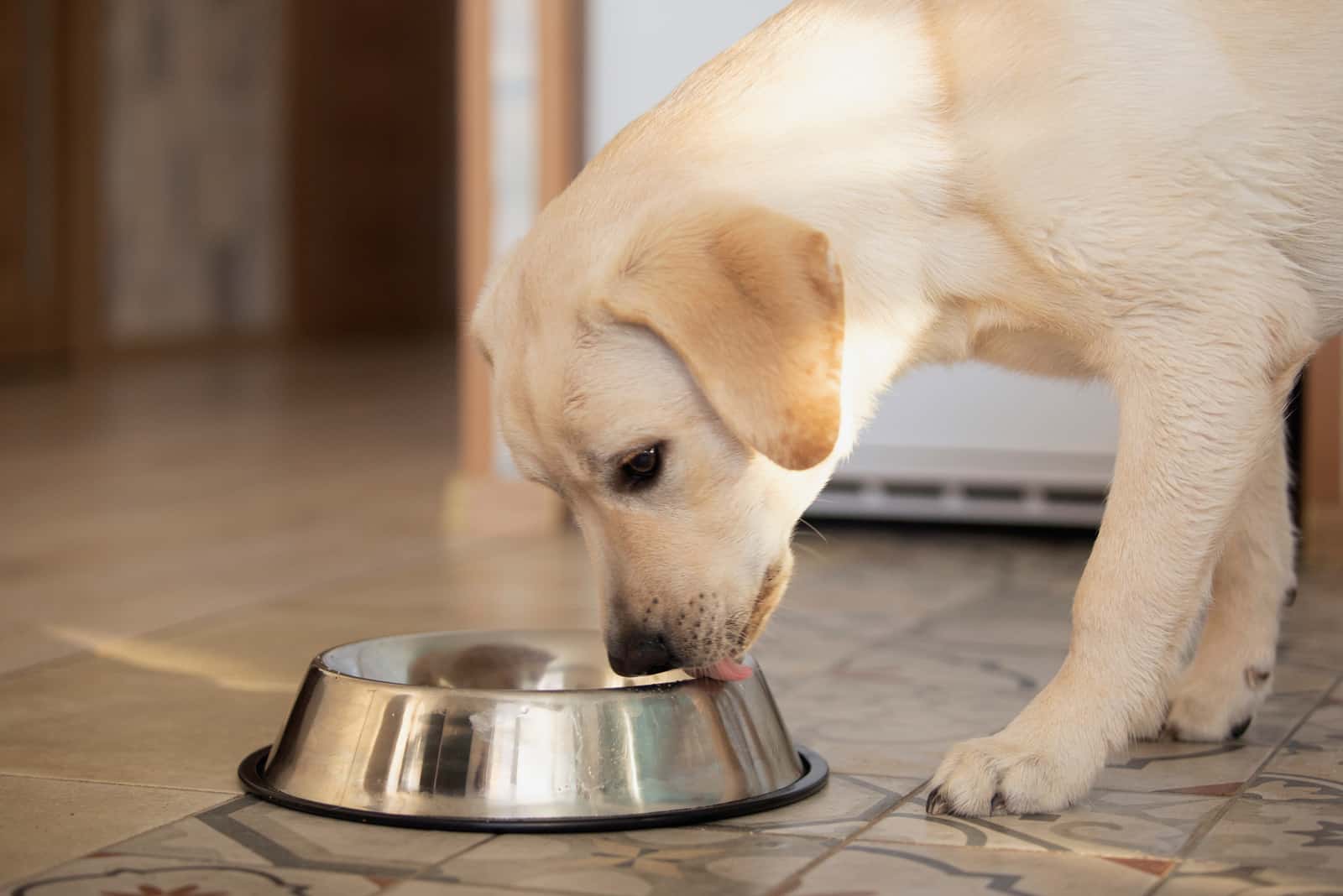
When first-time Labrador Retriever owners get their new puppy, the most frequent question I get asked is “How much should a Labrador puppy be fed?”
Well, there is no short answer to that, but I can tell you that Labrador puppy feeding requires some effort. Don’t worry, it is not as difficult as I made it sound!
Here is a Labrador puppy feeding chart that follows the puppy’s growth with its nutritional needs.
Birth To Two Weeks Old Labrador Puppy
We all know that when Labrador puppies are born, all of them are drinking their mother’s milk. Ingesting mother’s milk is the single most important thing a Lab puppy does when it comes to this world.
Labrador puppies usually open their eyes at two weeks of age, but that doesn’t mean that they can immediately start eating on their own. At two weeks of age, Lab puppies are still completely dependent on their mothers.
This is the period when you can see rivalry in the Labrador puppy litter. More dominant Lab puppies may consume more milk than is necessary, which leaves their siblings hungry. So keep an eye out for those mischievous little rascals and make sure that each puppy gets the same amount of their mother’s milk!
Three To Six Week Old Labrador Puppy
Three week old Lab puppies are growing healthy and strong. At this stage of life, Lab puppies are trying to get up, and most of them manage to sit straight. Physical activity that is as little as trying to stand up, requires a lot of energy for three week old puppies.
Labrador puppies are already burning off calories just by moving around, so they need more food! But, three week old Lab puppies still feed on their mother’s milk until their first baby teeth start to appear.
At four weeks of age, Labrador puppies can be introduced to new food — high-quality puppy food. And no, it is not too early to introduce them to new food because Lab puppies have started to grow their puppy teeth and their mother is starting to wean them off slowly.
Moving on to five weeks of age, Labrador puppies should already be introduced to puppy food and they should be eating it regularly. However, you should not immediately give your Lab puppy commercial dog food.
The transition period should go smooth and slow, to avoid your Labrador puppy developing diarrhea and upset stomach. Note that Lab puppies are not yet weaned at six weeks of age.
Six To Nine Week Old Labrador Puppy
The period between six and nine weeks is when Labrador puppies go through their first puppy growth spurt. During this period, Lab puppies are very active and all of them are walking around exploring the environment. Their little bodies require all the nutrients that they can get to keep moving and growing healthy!
The Labrador mother has done her part in feeding her puppies breast milk so now she decided to completely wean off her pups. The Labrador puppies are slowly becoming strong and independent canines!
At eight weeks old, the majority of Labrador puppies are ready to meet their new family (if they are put up for adoption). Some Lab puppies may still not be ready to go to their new homes, so it is best to approach each puppy individually.
By eight weeks of age, Lab puppies should already eat dry puppy food. In fact, they should eat more dry food than wet food. This is because Labrador puppies that consume wet food in the period of six to eight weeks of age have a rapid weight gain which isn’t good for their health.
Ten To Twelve Week Old Labrador Puppy
If you think that your Lab puppy’s growth spurt is over, think again! The period between ten to twelve weeks marks the biggest puppy growth spurt in the Labrador Retriever breed. During this period, you will have to feed your Lab puppy the most — up to three cups of high-quality puppy food daily. You may also try raw feeding your puppy along with its puppy food.
Although your Labrador puppy may always look hungry, make sure to avoid overfeeding. I know that at 11 weeks of age, Lab puppies use their cute puppy eyes to get what they want — but don’t be fooled! Overfeeding your young Lab puppy increases the chance of it developing early canine obesity.
When your Lab puppy is 12 weeks old, you can reduce the feeding frequency to two cups per day. So, you should give your 12 week old Lab puppy two full meals: one in the morning and one in the evening. However, you should squeeze one mini meal between breakfast and dinner because your Lab puppy is still growing!
Three To Six Month Old Labrador Puppy
By this time, your Labrador puppy’s appetite is through the roof! It will munch on everything it gets its little teeth on, so you should be careful around inanimate objects that your Lab puppy can get to.
Moreover, your three to six month old Labrador puppy must go through potty training to avoid pooping in the house.
Reputable Labrador Retriever breeders advise current and aspiring owners to provide their Labrador puppy with the best puppy food on the market. Only this way can a Lab puppy grow into a strong adult Labrador dog.
Six To Twelve Month Old Labrador Puppy
Are you wondering when do these puppies get easier?
Well, most Labrador puppies get easier once they reach twelve months of age. But, the period between six to twelve months requires lots of patience for Labrador owners.
Your Labrador puppy’s diet should include more than just plain puppy kibble. The transition between Labrador puppy and adult dog food should go slow, in order to avoid diarrhea and stomach issues.
Congrats, your Labrador puppy is all grown up and ready to eat adult dog food!
What Is A Labrador Retriever’s Adult Weight?
So, now that we know a thing or two about how long it takes for a dog to gain weight, it’s time to reveal the big news — Labrador Retriever’s adult weight.
Male Labradors are normally larger and sturdier than females, which makes them heavier. That said, an adult male Labrador Retriever weighs approximately 60 to 80 pounds.
On the other hand, female Labradors are more petite and reach about 55 to 75 pounds of adult weight.
Labrador Retriever Calorie Intake
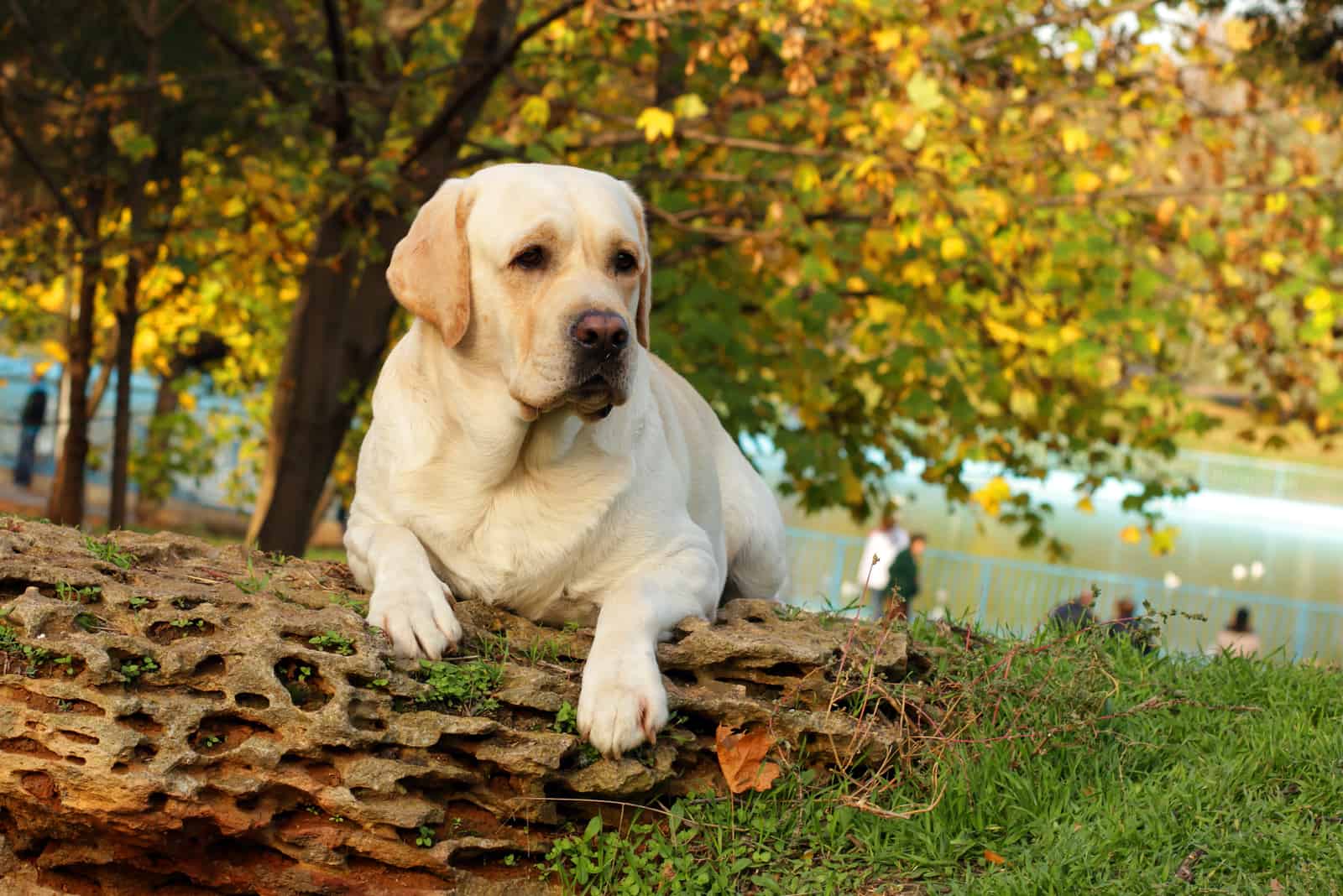
Calorie intake depends on the Labrador Retriever’s weight. If you own a 70 pound Lab, its body will need more calories than the 50 pound Lab. It’s not all about the Lab’s weight.
Activity levels and fitness will also raise the calorie intake. So, an adult Labrador dog that is active and healthy needs anywhere between 1600 to 2150 calories per day.
Don’t worry, so many calories won’t make your Labrador Retriever obese, as long as it is maintaining daily activity levels. This many calories per day will help to maintain your Labrador Retriever’s healthy body.
Think of calories as fuel for your Lab’s stamina and strength!
Note that large servings of dry kibble or puppy mush aren’t always a guarantee that your Labrador Retriever is getting enough calories.
Labrador Retriever Calorie Intake Chart Review
Male Labradors weigh between 60lbs and 80lbs, while females weigh in at between 55lbs and 75lbs
[table id=511 /]
How To Calculate Calories
Not sure how many calories your Labrador Retriever puppy needs in its balanced diet? Well, you can calculate your dog’s calories by using calorie calculators online. However, you can also try calculating a healthy calorie intake for your Lab puppy through a formula.
So, the best way to calculate how many calories a Labrador Retriever should take per day is by first weighing your Lab puppy. When you finish weighing your Lab puppy, its weight is expressed in pounds by 2.2. The result that you get should then be multiplied by 70 and then by 1.6.
But, I really recommend you use dog calorie calculators online for faster and more accurate results. The best thing you can do is ask a veterinary nutritionist to help you and your Labrador puppy out.
How To Read Dog Food Label
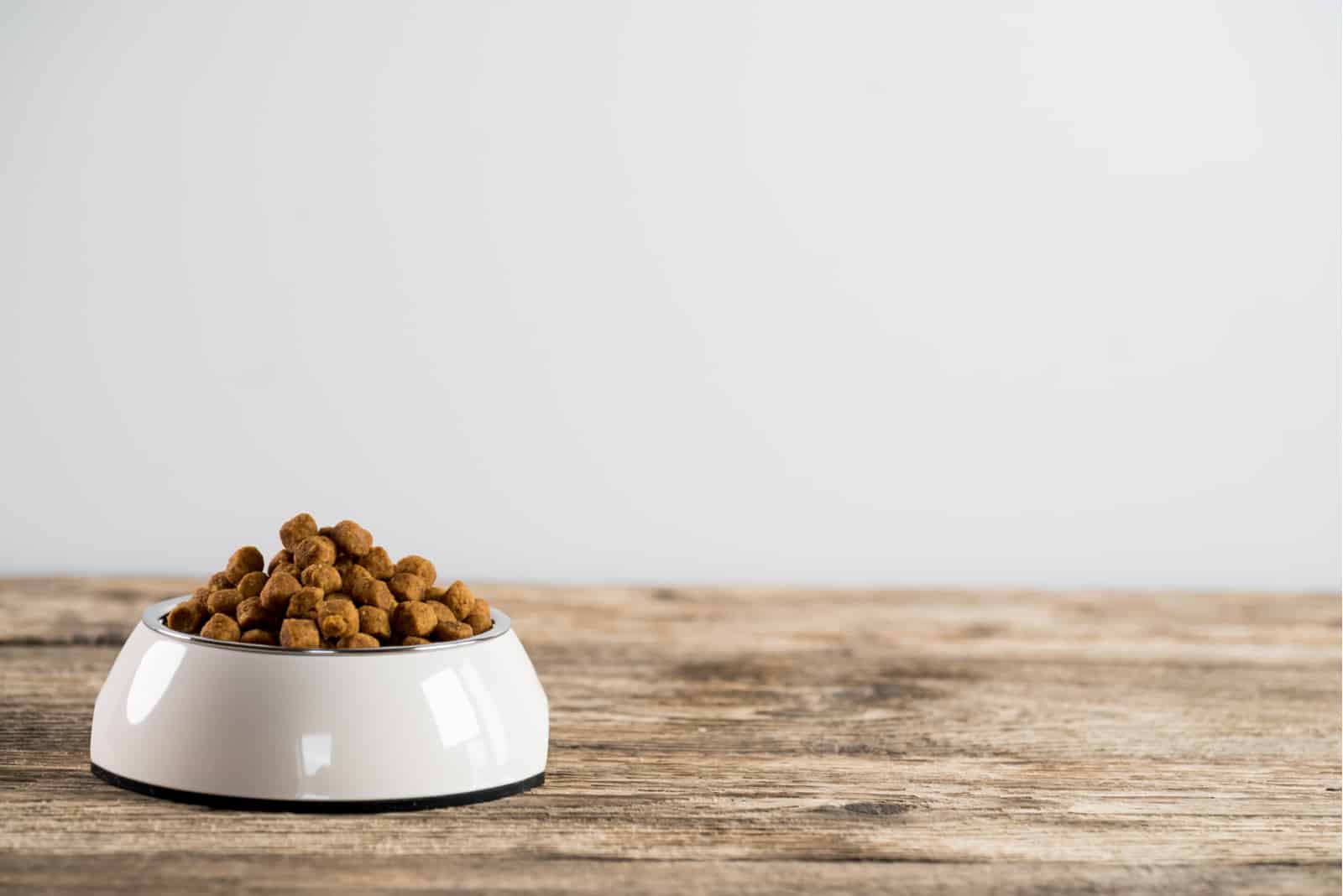
When choosing the best dog food for your Labrador Retriever, it is best that you know how to properly read dog food labels and ingredient lists. That way, you will know exactly what your Lab puppy needs and what ingredients to avoid.
For example, some Labrador Retrievers are allergic to grains, so you will want to choose grain-free dog food. But, how will you know what kind of grains are there if you don’t know how many grains there are in dog food?
Even though the majority of dog food brands put clear descriptions about their ingredients, there are some dog food brands that don’t.
Water, fatty acids, carbs, and protein are the four main ingredients that make up the majority of dog food.
Protein In Dog Food
Meat is typically mentioned as the first ingredient in high-quality dog food. Therefore, almost every Labrador Retriever dog food package typically lists the meat percentage.
Large breed dogs like Labradors need a lot of protein to grow healthy and strong. Even when they grow strong, adult Labradors require daily protein intake for energy and to maintain lean muscle.
Labrador adult dogs need at least 18% protein, whereas growing Labrador puppies need at least 22% protein (until they develop to their full size at 18 to 22 months of age). In other words, after all the water from the dog food has been taken out, the protein is evaluated on a dry matter basis.
But, these are also estimates Many experienced vets and Labrador Retriever owners recommend feeding adult Labs a balanced diet that contains 30% lean meat protein.
Others are all up for raw feeding Labradors with high-quality meat.
Raw food diet is considered the healthiest for most dog breeds, especially for the Labrador Retriever breed.
Adult Labradors should have 10% of their calories to come from protein. Commercial dog foods such as Kindfull dog food offer protein source from chicken, beef, turkey, fish, rabbit, and swine.
Fatty Acids In Dog Food
Labrador Retrievers need healthy fatty acids in their balanced diet. So, what are these fatty acids that are so important for Labradors?
Omega-3 and omega-6 fatty acids, and Docosahexaenoic acid (DHA) play a key role in the Labrador feeding chart.
Having said that, I advise you to look for dog food that contains these fatty acids. Fish-based foods are a common source of these beneficial fatty acids. Both wet food and dry kibble from the majority of high-quality dog food products contain these crucial components.
Fatty acids are beneficial because they make Labradors shed less and leave their coats shiny and healthy.
Omega-6 is more prevalent than omega-3 in many fats and oils, but Labrador Retriever’s dog food must have a balance of the two. The National Research Council (NRC) advises an omega-6 to omega-3 ratio of 2.6:1 to 26:1.
As for DHA that is used for therapeutic purposes, doses for Labrador dogs should not exceed 220 mg/kg body weight. The maximum dosage is advised for canine osteoarthritis.
Carbohydrates In Dog Food
Like all dogs, Labrador Retrievers are omnivores, so their nutritional needs for dietary carbohydrates do exist, but they are quite low. Protein and fat provide them with all of their nutritional needs.
There are split opinions on feeding your Lab carbohydrates because many dog owners fear of their pooch developing obesity. However, carbohydrates should be present in your Labrador’s food in low quantities when compared to other ingredients.
Choose nutritious sources of carbohydrates like brown rice, barney, sweet potatoes, oats, squash, millet, and berries. Additionally, you can fruit and vegetables both contain carbohydrates but are great for your Labrador to munch on between mealtime.
Most Labrador owners search for grain-free dog food because it supports a healthy digestive system.
Grain-Free Dog Food For Labrador Retriever
Grain-free Labrador Retriever dog food is basically dog food without grains like brown rice, millet, corn, barney, and so on.
Having said that, grain-free dog food for Labrador Retrievers is packed with alternative carbohydrate sources such as potatoes and pea flour.
However, there is a constant debate about grain-free dog food because grains are frequently substituted for legumes, which may result in canine dilated cardiomyopathy (DCM).
Veterinarians and nutritionists believe that grain-free diets can deprive your Labrador Retriever of fiber, fatty acids, and protein.
On the other hand, grain-free dog food for Labs comes with several benefits:
• Grain-free dog food causes your Labrador Retriever to stop farting so much
• Gives your Labrador Retriever healthy-looking skin
• Reduces your Labrador Retriever’s bad breath
• Provides your Labrador Retriever with more energy
Glucosamine & Chondroitin In Dog Food
Labrador Retrievers are big dogs that are known to suffer from joint and bone problems. Sometimes, these large breed puppies need supplements that help maintain healthy bone and muscle mass.
The two main ingredients present in the majority of canine joint supplements are glucosamine and chondroitin. These two are also present in some high-quality dog food.
Glucosamine and chondroitin are naturally occurring components of cartilage and they are crucial for preserving healthy joint function and assisting in reducing the aches and pains that so many Labrador Retriever dogs with canine arthritis endure.
All meat-based commercial dog foods contain modest levels of glucosamine since it is naturally present in animal bones and bone marrow.
For the treatment of osteoarthritis in dogs, glucosamine hydrochloride (HCl) and chondroitin sulfate (CS) are frequently suggested natural health supplements.
Labrador Feeding Chart: Things To Consider
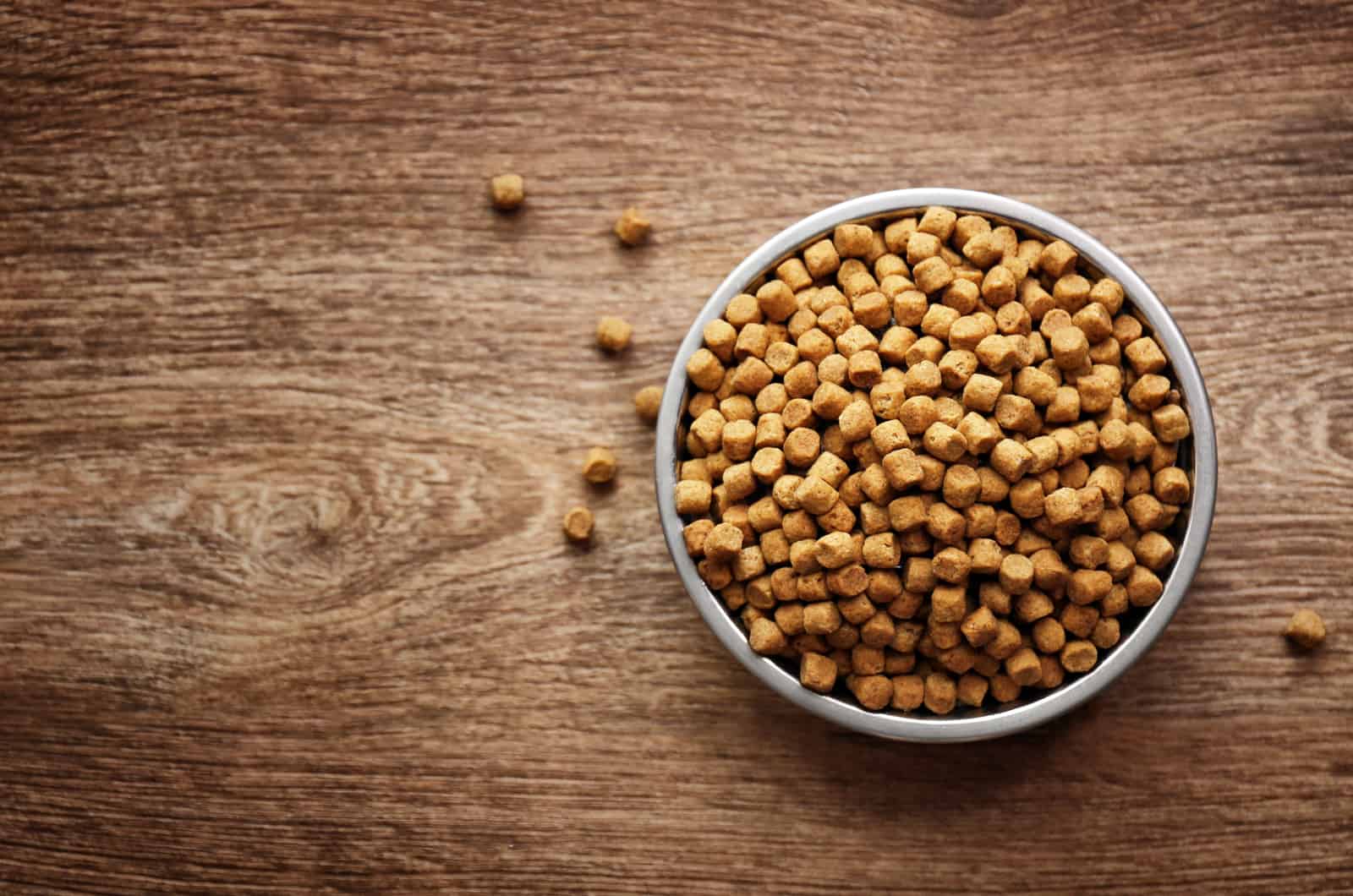
When choosing the type of food for your Labrador Retriever, there are some things that you have to keep in mind.
Not all Labrador Retriever dogs require the same amount of food and the same feeding schedule. Just like adult humans and babies, Labrador Retriever’s diet varies depending on their age.
Labrador’s diet also depends on gender and the overall health state the dog is in. Here’s what I’m talking about:
Gender
Male and female Labrador Retrievers are different in terms of size and body structure. Naturally, male Labrador Retrievers are larger and require more food intake than their female counterparts.
But, each Labrador Retriever dog, regardless of its gender, is an individual and it is going to have different nutritional needs. Some Labradors love food more than the others, and that is perfectly fine.
Pregnant female Labrador Retrievers need a special and well balanced diet to keep their bodies in good condition. It is crucial that Labrador Retriever puppies get enough nutrients while in their mother’s womb.
Age
It is pretty simple, Labrador Retrievers in different life stages require different diets.
A healthy puppy diet that is full of nutrients works great for Labrador Retriever puppies in development. An adult diet with carefully selected ingredients does wonders for adult and senior Labrador Retrievers.
That said, a 3-month old puppy can’t be fed the same diet as the three-year old Labrador dog. Labrador puppy owners know all too well that their little fur balls need frequent meals that are packed with vitamins (AD3E) and minerals (Iron, Zinc, Calcium).
Moreover, puppy food and adult dog food are different in calorie and nutrient percentage. That is why puppy food and adult dog food are manufactured, packaged, and sold separately.
Health Status
Healthy Labrador Retrievers have good appetites, whereas Labs that are suffering from certain health issues need some help with eating and bringing back their appetite.
Having said that, unhealthy Labrador Retrievers require a special kind of diet. Sometimes regular pet food may not work as much as homemade dog food that is followed by specialized dog food (like Royal Canin Labrador Retriever and Purina Pro Plan).
Labrador Retrievers with yellow poop may show signs of food intolerance, so it is important to keep track of your dog’s feeding schedule.
Labrador dogs that poop too much should also be monitored and have their diet changed.
Activity Levels
Active Labrador Retrievers need more food than lazy ones! In fact, lazy Labs are more prone to obesity than those that regularly exercise. Wait, is there such a thing as a lazy Labrador Retriever?
A healthy Labrador dog typically needs two to three hours of daily exercise. In addition to regular physical activity, Labrador puppies should have a healthy dose of mental stimulation throughout the day.
How often you walk your dog depends on its food intake which leads to its need to go potty.
The Labrador’s nutritional needs are influenced by how busy it is, both physically and cognitively.
Active Labrador Retrievers burn off calories faster and become hungry in a matter of minutes! Maintaining healthy activity levels and a balanced diet is the key to healthy weight gain.
Labrador Retriever BARF Diet
The terms “Biologically Appropriate Raw Food” and “Bones and Raw Food” are the acronyms for the B.A.R.F.
BARF is primarily viewed as being more natural, species-appropriate, and hence healthier than conventional dry or wet food. However, the BARF diet approach has not yet been scientifically proven to be healthier.
In addition to offering the extra advantages of containing vegetables, seeds, nuts, and fruits, BARF meals are superior to other raw meat diets because they give your Labrador dog a more nutritious and well-balanced meal.
Additionally, the BARF diet does not contain any fillers, GMOs, artificial colorings, and preservatives.
Giving Supplements To A Labrador Puppy
The ingredients are the reason you feed your lab puppy puppy food rather than adult dog food. Because puppy food is designed for growing dogs, it contains more nutrients and calories than adult food.
As a result, you won’t have to give your puppy any supplements. Actually, because puppy food is typically enriched, you may be giving your puppy too many vitamins and minerals.
Too much calcium is more harmful than beneficial. If you want to supplement your lab’s diet with glucosamine to prevent joint problems, consult with your veterinarian about when this is appropriate.
What Home Food Is Good For Labradors?
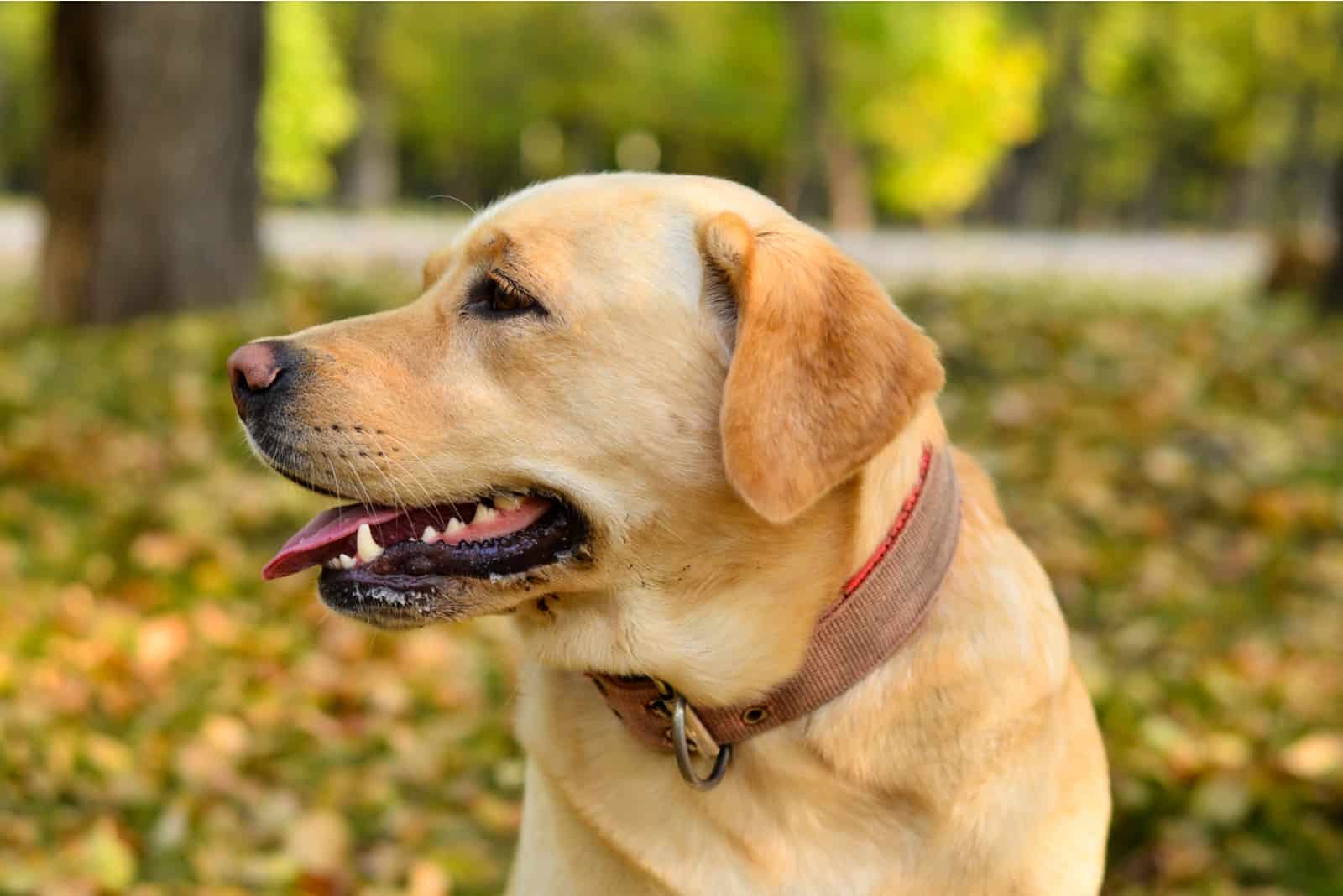
There are plenty of great homemade dog food recipes that you can find on the internet. But, not everyone has the time to make homemade meals for their pooches.
The most delicious and easiest dog food to make at home starts with bone broth. Bone broths for dogs are usually made by cooking beef bones along with carrots and a bit of celery.
Even though it is easy to put all of these ingredients together in a big pot, cooking homemade bone broth for your dog may take up to nine hours. This is why there are versatile premade bone broths for dogs that are available on the market.
Homemade dog food for Labrador Retrievers should consists of ingredients such as:
• Meat: beef, turkey, pork, chicken, lamb
• Vegetables: carrots, beets, celery, sweet potatoes, brussels sprouts, parsley, peas, green beans
• Safe oils: olive oil, vegetable oil, coconut oil
When it comes to preparing meat, it is best to use ground meat or beef marrow bones for bone broth. Make sure that all the meat that you use in serving your dog homemade dog food is bone-free.
If your Labrador Retriever is suffering from certain health issues, then you should ask your veterinarian about which ingredients to choose for a homemade therapeutic diet.
For example, dogs with kidney disease require a special diet that is packed with healthy fatty acids, but low in sodium, protein and phosphorus.
Is Rice Good For Labrador?
Rice, especially brown rice, can be found in many commercial dog food labels as one of the basic ingredients. Rice of any kind is not present in grain-free dog food.
Feeding your Labrador Retriever rice is good for its immune system and metabolism. Cooking bone broth and combining it with rice is great for Labradors that are on a special diet. However, you should not feed your Labrador full rice meals every day.
Is Chicken Good For Labrador?
Of course it is!
Chicken is a healthy and natural source of protein for your Labrador Retriever dog. The best way to prepare chicken for your dog is by boiling it until it is well-cooked. Just be sure to get rid of bones after you’re done boiling the chicken.
As they cook, chicken bones become brittle and easy to break. When your Labrador Retriever munches on them, chicken bones get broken down into smaller, sharper pieces that can make a mess in your Labrador’s digestive system. So, don’t feed your Lab chicken bones!
How Much Chicken Does A Labrador Need?
Raw chicken can be given to a Labrador dog from 1/4 to 1/3 cups for every 20 pounds of its body weight. In other words, on a daily basis, you can feed your Labrador Retriever raw or partially cooked chicken that is 2 to 3% of its body weight.
It might sound confusing, but calculating how much chicken your Lab needs is pretty simple. Say your Lab weighs 65 pounds (roughly 30 KGs). You take your Labs body weight in KGs and divide it by one hundred (0.3 = 300 grams) and multiply it by 2 and you will get 600 grams which is 1 lb, 5.16 oz.
Can I Feed My Dog Rice And Chicken Everyday?
Too much of anything isn’t good for your Labrador Retriever. You too would get bored of eating rice and chicken everyday, am I right?
Besides that, feeding your Labrador Retriever rice and chicken everyday isn’t healthy because this diet isn’t versatile enough to be fed every single day — it doesn’t provide your dog with all needed nutrients.
While you can feed your Labrador rice and chicken every now and then, it is not advisable feeding it this diet everyday.
Is Boiled Egg Good For Labrador?
Most homemade recipes for Labrador Retrievers include boiled eggs! Whether soft or hard-boiled, eggs are great for all dogs, including large dogs like Labradors!
This is like super food for your dog because one egg contains high amounts of vitamins, fatty acids, and protein that help boost your Labrador Retriever metabolism.
Is Milk Good For Labrador?
This is one of those frequently asked questions that most pet owners worry about. Just like humans, Labradors can be lactose intolerant. So, for lactose intolerant Labradors milk is a no-no.
Small amounts of cow or goat milk is perfectly fine to give to your Labrador Retriever dog. But you don’t want to give your Labrador a bowl full of milk.
Don’t give too much milk to Lab puppies because they might develop diarrhea that will keep you awake at night.
Other dairy products like whipped cream and cheese can be incorporated into Labrador’s diet, but in small amounts. You can take your Labrador to Starbucks every so often, but don’t make it a daily routine.
What Human Foods Can A Labrador Puppy Eat?
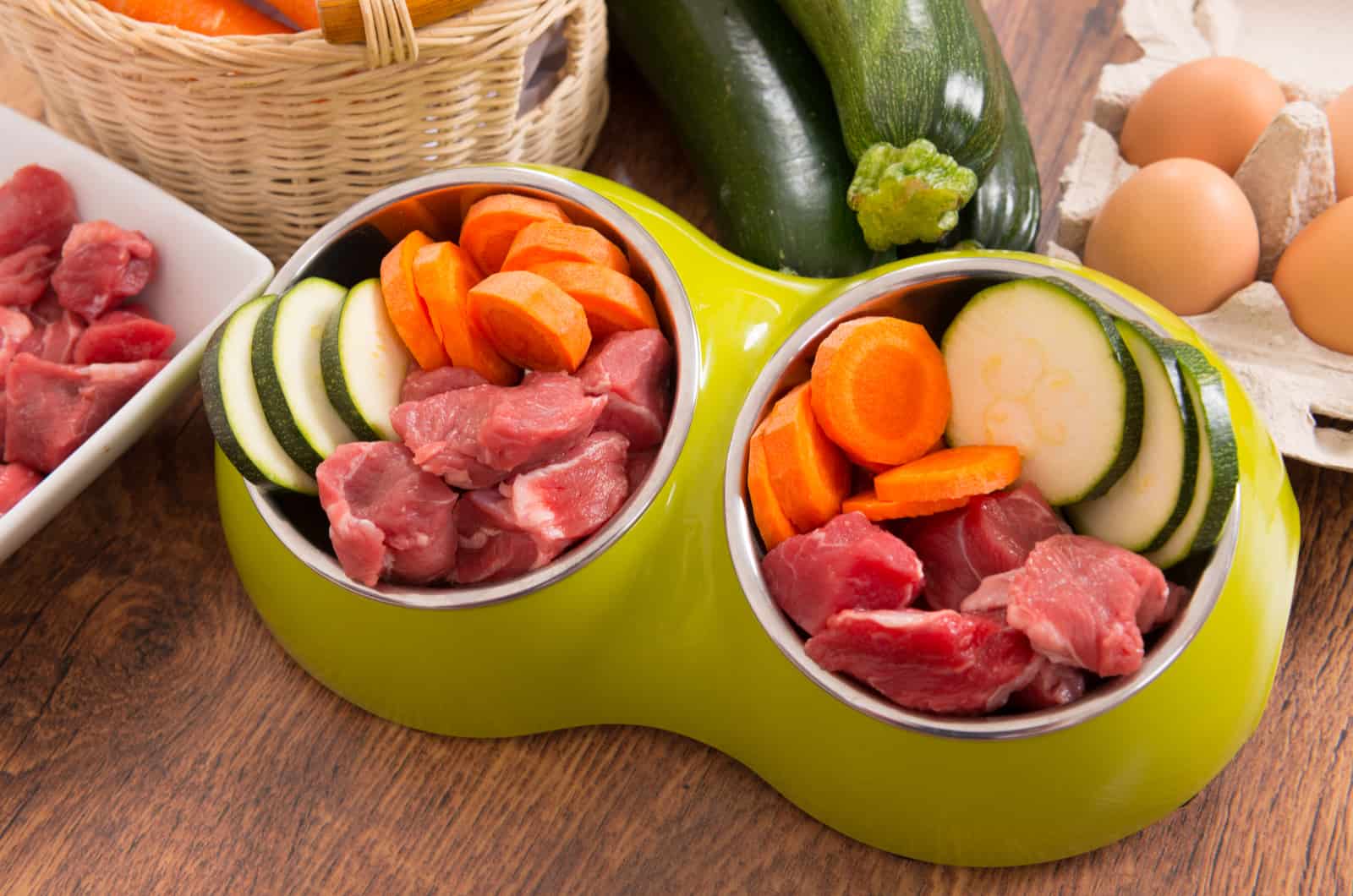
Firstly, if a Labrador puppy is less than eight weeks old, you shouldn’t experiment with giving it a variety of human foods.
After it reaches eight weeks of age or more, it is best to start with giving your Lab puppy simple chicken and rice meals, along with a rich bone broth.
To make it short and simple, when they turn eight weeks old, Labrador puppies can eat the following human foods:
• Peanut butter
• Eggs
• Fish
• Chicken
• Beef
• Pork
• Greek yogurt
• Bread
Dairy products like blue cheese should be avoided or replaced by Cheddar or Swiss cheese (in small amounts).
Same goes for bread and other pastry products like pretzels. Labradors can eat them, but on rare occasions and small amounts. Pretzels contain too much salt, so they should not be given to Labs.
Remember, feeding your Labrador Retriever puppy human food should not be your everyday habit nor should you serve your puppy a whole leftover meal from your lunch.
What Fruits And Vegetables Can Labradors Eat?
There are many fruits and veggies that Labradors are allowed to eat, but there are also some that should be avoided at all cost.
If your Lab happens to eat a small amount of forbidden fruit or vegetable once, it won’t be in danger. But, if your Labrador eats quite the amount of no-no food, then you might want to monitor it for any signs of sickness.
List Of Safe Fruits For Labrador Retrievers
Incorporating yummy fruits into Labrador’s diet is a great way to ensure that your Lab is getting enough vitamins and minerals. Fruit makes your Lab’s balanced diet even more versatile!
If your Lab is going crazy for certain fruit, then this can be used in positive reinforcement training as a healthier substitute for dog treats.
Here is some fruit that is safe for your Labrador to eat:
• Bananas
• Pineapple
• Blackberries
• Coconut
• Blueberries
• Papaya
• Mango
• Strawberries
• Watermelon
Besides “basic fruits” your Labrador Retriever can also eat exotic fruit such as guava, but in small amounts.
List Of Safe Vegetables For Labrador Retrievers
Now let’s see what kind of veggies are safe for Labrador Retrievers. When it comes to vegetables, there are some that can color your Labrador’s poop green or cause your Lab’s tummy to bloat. So, it is important to know what veggies are safe for your Labrador Retriever.
• Spinach
• Corn
• Green beans
• Broccoli
• Kale
• Brussels Sprouts
• Carrots
• Turnips
• Celery
• Cucumber
Veggies are packed with essential vitamins and nutrients that give your Labrador Retriever a healthy glow!
What Human Food Should Not Be Given To Labrador?
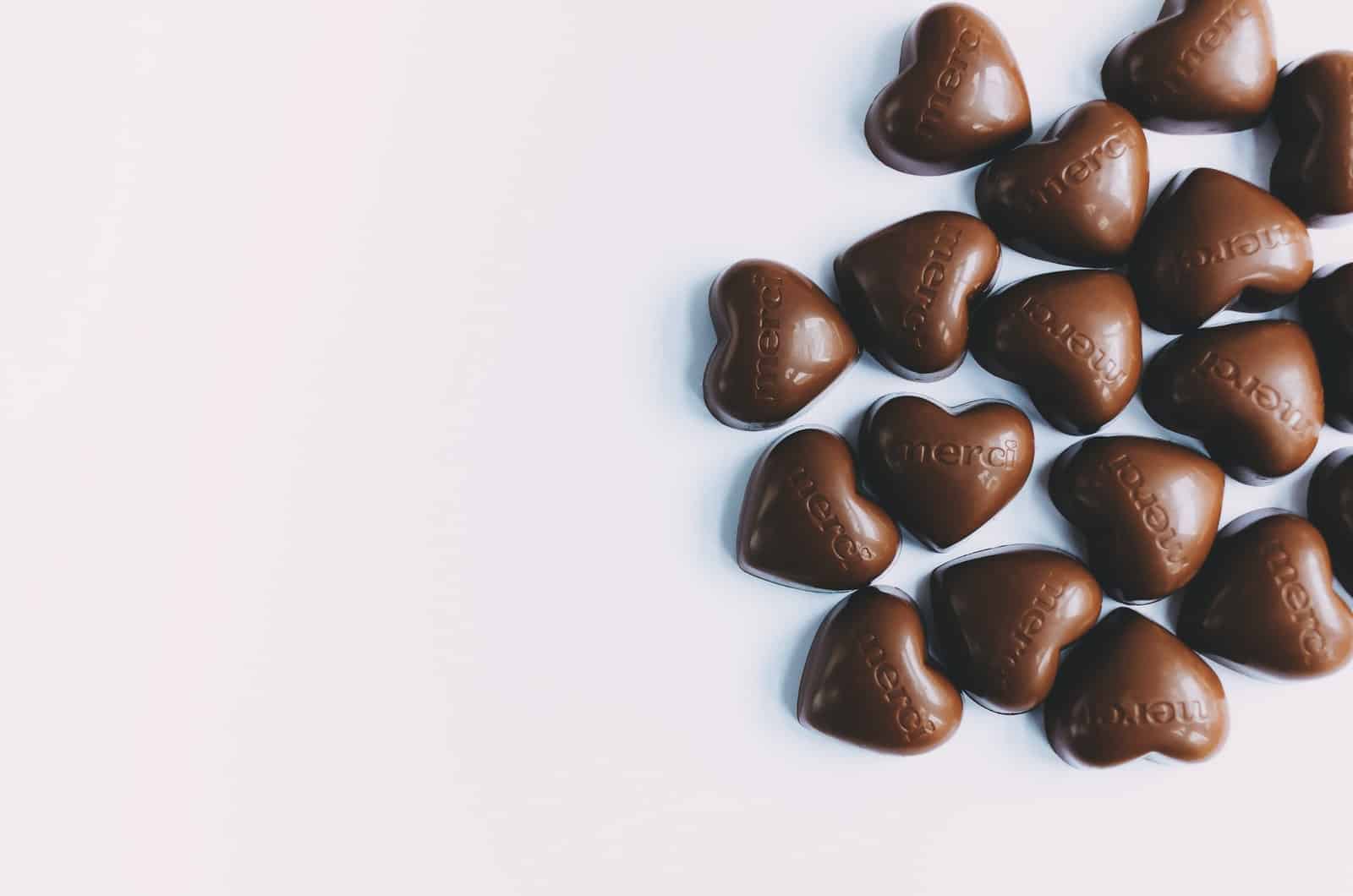
Although there is a lot of human food that is allowed in the Labrador Retriever diet, certain human foods are a big no!
More often than not, Labrador Retrievers will eat whatever they find in front of themselves, so be careful not to have these things lying around:
• Chocolate
• Garlic, onions, and chives
• Candy
• Corn on the cob
• Macadamia nuts
• Japanese horseradish (wasabi)
Even though they are not toxic to dogs, vegetables like bell peppers and jalapeno peppers should not be found in your Labrador Retriever’s diet.
What Fruit Is Poisonous To Labradors?
Not all fruit is good for Labrador Retrievers. Here is a list of poisonous fruit that every Labrador Retriever should avoid:
• Grapes
• Raisins
• Fruit pits (plum and peach)
• Cherries
• Avocado
• Green tomato
What Meat Should Labradors Not Eat?
Although they technically can (and most want to), Labradors and all other dog breeds should not eat processed meats like vienna sausages, hot dogs, ham, and salami. These products contain a high percentage of fat and sodium, thus being bad for your Labrador Retriever.
Fried meat such as bacon is also something that Labrador Retrievers should avoid in their balanced diet. Fish sticks are also considered as processed food that is high in fat and should not be given to your dog.
Most dog owners believe that spam is good for their dog, but this meat product also falls under processed meat that is mixed with several seasons that are bad for Labrador Retriever dogs.
What About Water? Daily Water Intake For Labrador Retrievers
Daily water intake for Labrador Retrievers varies depending on their age. But, regardless of their age, all Labradors must have access to fresh water all the time.
After the Labrador mother weans her puppies, they will need to drink at least half a cup of water every two hours.
Make sure to remove the water bowl at night because your Labrador is going to drink lots of it and you will find yourself going out for walkies in the middle of the night.
Let’s Wrap It Up
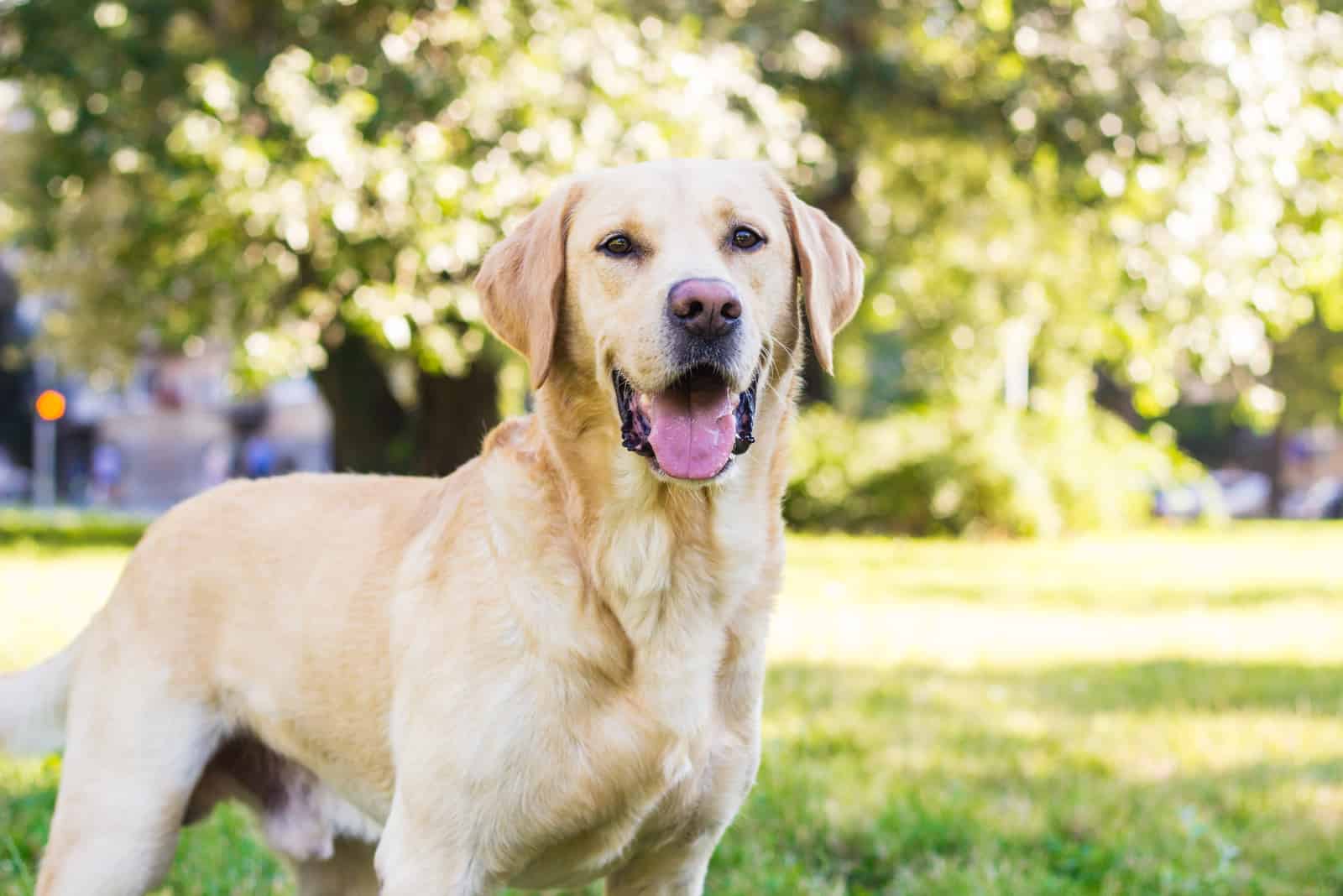
There is quite a lot to this Labrador feeding chart, right? Although it may seem like much, this information is memorized easily. When feeding your Labrador puppy, make sure to follow feeding guides that are written on the back of every high-quality dog food packaging.
As a responsible dog owner, you will have to pay attention to what your Labrador Retriever might get its mouth on! Don’t leave a chocolate bar on the table because your Labrador Retriever will definitely want a piece of it!
Take this Labrador feeding chart and follow your puppy’s healthy development!
Related Content
Why Do Dogs Eat Cat Poop: 6 Reasons And How To Stop It
